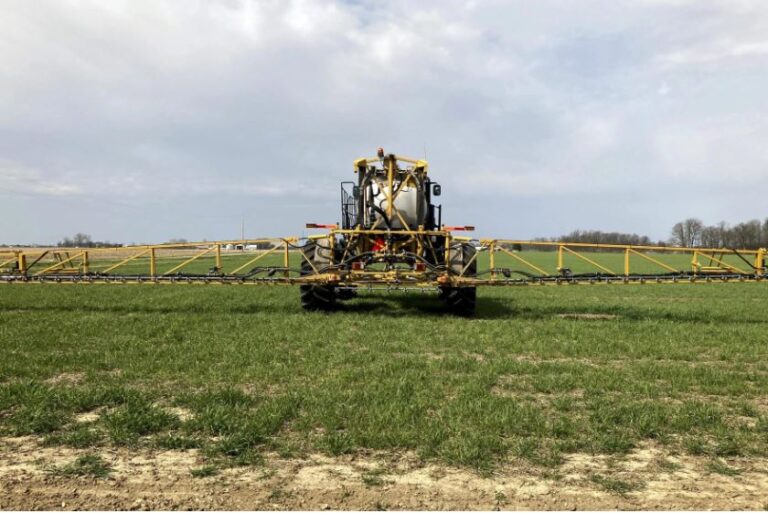CHAMPAIGN — Illinois State Conservationist Ivan Dozier is happy to explain the reasons why $18 billion has been set aside for United States Department of Agriculture (USDA) farm conservation programs within the bipartisan Inflation Reduction Act of 2022, a $740 billion climate, tax and healthcare spending package signed into law by President Joe Biden this summer.
“I think it’s important to note that the majority of these funds will go directly to land owners and land operators to help them implement conservation practices,” said Dozier, who administers conservation programs to Illinois farmers and landowners through his role with the USDA’s Natural Resources Conservation Service (NRCS), located in Champaign.
“We know that these conservation practices and programs are effective; we just need more of them. This is unprecedented funding that can make a huge difference in not only addressing agriculture’s contribution to some of the problems we see, but also to have a positive impact on some of these issues that go beyond agriculture’s contributions to these problems — including nutrient management, carbon management and greenhouse gasses (GHG).”
Listen to this story here.
More conservation on Illinois farms
The unprecedented funding Dozier referred to will help more Illinois farmers install conservation practices on their grounds that can maximize field nutrient (fertilizer) loss prevention and promote soil stabilization. Some of these practices include the planting of cover crops (off-season or overwintering plantings of cereal rye, pennycress or other alternate crops that can help keep fall-applied nutrients within farm field borders), installation of field drainage tiles and reduced tillage. Newer field conservation practices include the installation of woodchip bioreactors that serve to filter nitrates out of excess water draining through crop field tiles.
“A lot of what we focus on is just trying to minimize disturbances to the soil, to keep the ground covered as much as possible to minimize erosion,” Dozier said.
To help farmers and rural landowners implement these and other field conservation strategies, the Inflation Reduction Act allocates $8.45 billion to the Environmental Quality Incentives Program (EQIP); $4.95 billion for the Regional Conservation Partnership Program (RCPP); $3.25 billion for the Conservation Stewardship Program (CSP); and $1.4 billion for the Agricultural Conservation Easement Program (ACEP).
More one-on-one help for farmers, landowners
In addition to the $18 billion to boost USDA-NRCS conservation programs, another $1 billion will go to NRCS for conservation technical assistance. $300 million will also go to NRCS to track and measure the impact of farm conservation practices on GHG emissions. This funding will facilitate the hiring of more conservation practice technicians to assist landowners and farmers in implementing approved conservation measures, according to Dozier.
“It’s one thing to provide more money to make programs available to more farmers, but it also takes people who have some skills to be able to read the land,” he said. “We have opportunities for soil conservationists and soil conservation technicians, but also wildlife biologists, foresters, soil health specialists (and others) all across the technical spectrum that it takes to get conservation practices customized for a farm. This is a tremendous career opportunity for people who are interested in having a positive impact on the environment.”
Inflation Act funding will spark farm bill debate
Funding for USDA conservation programs has, historically, been appropriated through the farm bill’s conservation title. While the Inflation Reduction Act will vastly increase conservation program budgets in the short-term, there is also a push among some lawmakers to boost farm conservation dollars through the soon-to-be-negotiated 2023 Farm Bill, which will determine annual program funding for the next five years.
Citing a “remarkable change” in farmers’ views towards agricultural conservation programs, U.S. Sen. Dick Durbin (D-Ill.) visited a southern Illinois farm to call attention to the historic Inflation Reduction Act investment and urge 2023 Farm Bill writers to follow suit by increasing annual conservation title appropriations.
“We should be funding this at a higher level,” said Durbin, a member of the Senate Ag Committee. “I’m hoping this new farm bill is an opportunity to do that.”
Dozier agreed, while predicting 2023 Farm Bill writers could direct increased funding towards establishing new conservation programs.
“We might see new programs that are more focused under the new farm bill, in addition to these funds that have been outlined to go to the existing programs,” said Dozier. “I think it provides us with an opportunity to maybe fine-tune and focus even more within the new farm bill on what kind of new activities need to take place.”
Opposition muted by program demand
Opposition to Inflation Act spending has been led by House Republicans who say the bill would increase federal spending by more than $400 billion over ten years. In defense of the bill’s conservation funding, Dozier and other proponents point to the recent oversubscription to popular NRCS programs, including CRP and EQIP, as proof that additional funding is necessary to meet demand.
“Fewer than half of the farmers that apply for these programs receive funding. We know that the farmers in Illinois and this country, just by the numbers, who want to get more conservation out there. I certainly think this will help,” said Dozier, who has not yet received information on exactly how much of the $18 billion in federal conservation program allotment will be available for Illinois farmers and landowners.
Increasing the funding for programs that encourage conservation on farmland will also serve to have a positive impact on sensitive Illinois watersheds, such as Lake Decatur, that supply drinking water for municipalities and townships, Dozier added. He said such funding will also help to reduce Illinois farmers’ nitrate losses that ultimately contribute to the hypoxic zone in the northern Gulf of Mexico.
42,218 Illinois farmers and landowners were enrolled in CRP as of June 2022, covering 825,794 acres, according to the USDA’s Farm Service Agency. More than 22 million acres were enrolled nationally, with a cap limit of 27 million acres for 2023 programs.

